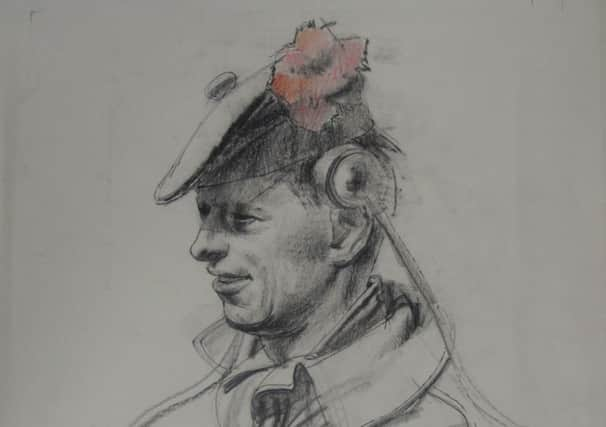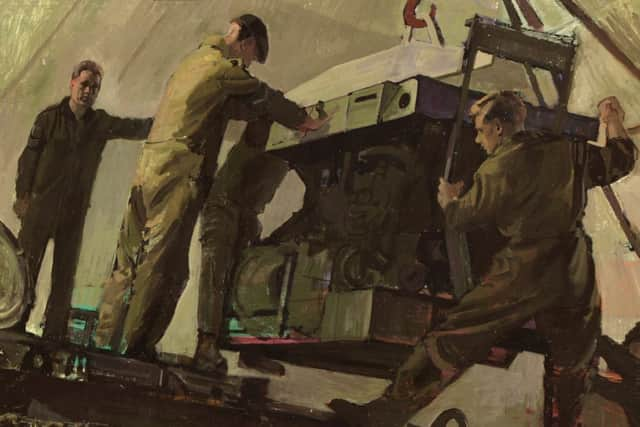‘Swirling kilts’ banned from Black Watch paintings


Professor Ron Stenberg, who was asked to undertake the task in Minden in west Germany in 1968, said the regiment’s Lieutenant Colonel Earle Nicoll would make regular inspections of his work to prevent “artistic licence” being taken.
However, the collection, known as “The Stenberg Pictures” which include paintings of soldiers map-reading and searching for explosives also feature a painting called Band Practice and a number of sketches which the artist managed to complete, contrary to orders, capturing a more informal picture of life in the regiment.
Advertisement
Hide AdProf Stenberg, who was given leave of absence from his job as a lecturer at Duncan of Jordanstone College of Art in Dundee to travel to Germany, said: “I was asked to portray the Scottish soldiers in uniform with weapons and equipment. I was thrilled to be asked to paint them.


“I didn’t want any ‘rank’. I just wanted to mix in and talk to the soldiers as ordinary men. My remit was to record men from privates through all ranks to officers and regimental sergeant majors, a good likeness for all grades.”
Speaking from his home in Auckland, New Zealand, Prof Stenberg continued: “Lt Col Nicoll said there was to be no artistic licence allowed, no swirling kilts or anything like that, just a precise record of a moment in time and the uniforms had to be exact.
“He checked each one I did to make sure all details were correct. The kilt had to be tip of the knee and so forth, hanging straight. All these things had to be adhered to.
“The men who sat for me had no choice, they had to be models. I remember the drummer who said ‘for Christ’s sake hurry up, this bearskin’s killing me.’ He said he had been ‘out on the batter’ the night before and was nursing a hangover of monumental proportions.
“But the main things the soldiers talked about was money, beer and going on leave.”
Advertisement
Hide AdProf Stenberg, who served in the army during the Second World War added: “But despite not being allowed my artist’s licence and being told to do exactly as I was told, I managed to do a couple of things for myself. I did one of a band practice of which I was very proud. It was informal and captured what I saw myself.”
The artist’s visit had been suggested by Major Colin Innes, Adjutant of the 4/5th Battalion The Black Watch (TA) who had previously commissioned Stenberg to paint a highly-popular picture of Colour Sergeant Nobby Clark of the TA Battalion standing at the Black Watch Powrie Brae War Memorial in Dundee.
Advertisement
Hide Ad“I said to my commanding officer Col Nicholl, ‘I’ve got an artist in Dundee, he’s frightfully good with the Jocks. That was important because some people see a Highland regiment and may not identify too quickly with them. Luckily he saw the point of my suggestion that we should get the men and their lives recorded.
“Ron could capture personality quite quickly. His work on the bank playing showed how he could just sit there and draw and shows the genre of his paintings.
Emma Halford-Forbes, curator of the Black Watch museum at Balhousie Castle in Perth, which has five Stenberg oil paintings and 2-30 original pencil and charcoal sketches, said his work brought everyday soldiering to life.
“The key thing about Ron Stenberg’s paintings were that they were of soldiers doing everyday jobs. If there was a gun in their hand, they were in training.
“People are always surprised that they are of soldiers doing normal tasks. You would be hard-pressed to find military pictures by war artists when hey are not at war.”
HISTORY OF THE BLACK WATCH
The Black Watch was raised in the aftermath of the Jacobite Rebellion and comprised Highlanders from loyal clans such as Campbells, Grants, Munros and Frasers.
Advertisement
Hide AdIts name was derived from the dark colour of its tartan and its role which was to “watch” over the Highlands. In 1795 it adopted the distinctive red hackle which was worn in the soldiers’ bonnets.
It saw active service across the world including its first action at the Battle of Fontenoy in 1745 to active service in the West Indies, North America during the American War of Independence, the Napoleonic Wars, Waterloo, India, the Crimean War, the Boer Wars, the two World Wars and Korea.
Advertisement
Hide AdIt was also deployed in a peace-keeping role in Kenya, Cyprus, Northern Ireland and the Balkans.
More recently it played a strategic role in the American-led invasion of Iraq in 2003.
In 2004 it was announced that the Black Watch would join five other Scottish regiments to form the Royal Regiment of Scotland. The regiment is now known as The Black Watch (3rd Battalion, Royal Regiment of Scotland).
The award-winning play Black Watch, written by Gregory Burke and directed by John Tiffany was based on interviews with former soldiers, portrays men in the Black Watch regiment serving in Iraq in 2004 prior to the amalgamation.
SEE ALSO: